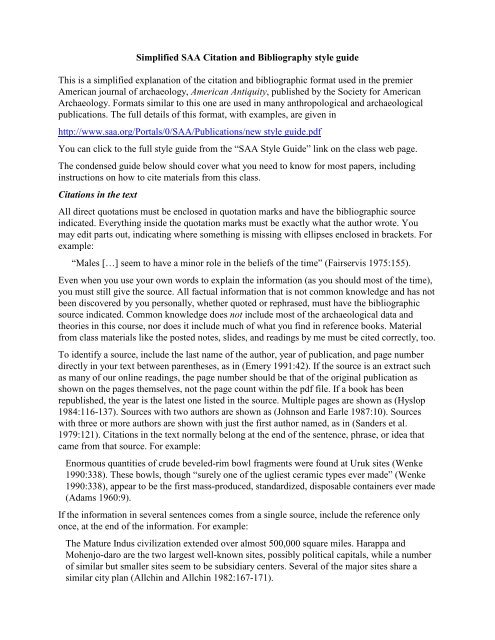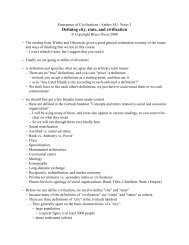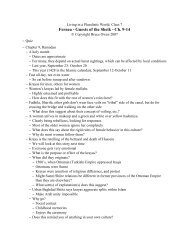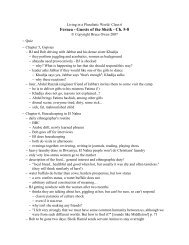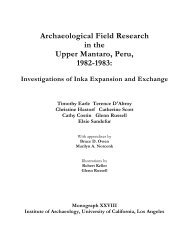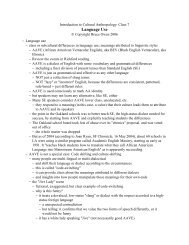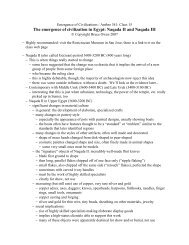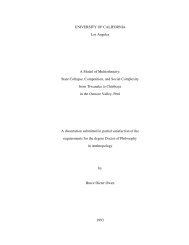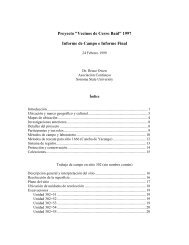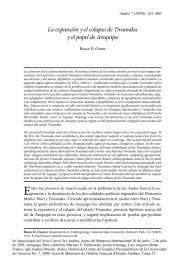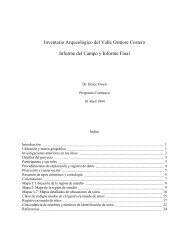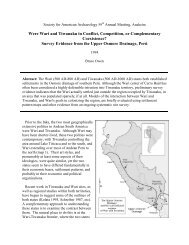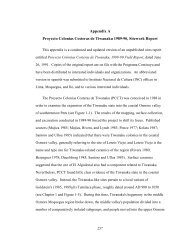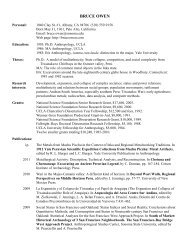Simplified SAA Citation and Bibliography style guide ... - Bruce Owen
Simplified SAA Citation and Bibliography style guide ... - Bruce Owen
Simplified SAA Citation and Bibliography style guide ... - Bruce Owen
Create successful ePaper yourself
Turn your PDF publications into a flip-book with our unique Google optimized e-Paper software.
<strong>Simplified</strong> <strong>SAA</strong> <strong>Citation</strong> <strong>and</strong> <strong>Bibliography</strong> <strong>style</strong> <strong>guide</strong><br />
This is a simplified explanation of the citation <strong>and</strong> bibliographic format used in the premier<br />
American journal of archaeology, American Antiquity, published by the Society for American<br />
Archaeology. Formats similar to this one are used in many anthropological <strong>and</strong> archaeological<br />
publications. The full details of this format, with examples, are given in<br />
http://www.saa.org/Portals/0/<strong>SAA</strong>/Publications/new <strong>style</strong> <strong>guide</strong>.pdf<br />
You can click to the full <strong>style</strong> <strong>guide</strong> from the “<strong>SAA</strong> Style Guide” link on the class web page.<br />
The condensed <strong>guide</strong> below should cover what you need to know for most papers, including<br />
instructions on how to cite materials from this class.<br />
<strong>Citation</strong>s in the text<br />
All direct quotations must be enclosed in quotation marks <strong>and</strong> have the bibliographic source<br />
indicated. Everything inside the quotation marks must be exactly what the author wrote. You<br />
may edit parts out, indicating where something is missing with ellipses enclosed in brackets. For<br />
example:<br />
“Males […] seem to have a minor role in the beliefs of the time” (Fairservis 1975:155).<br />
Even when you use your own words to explain the information (as you should most of the time),<br />
you must still give the source. All factual information that is not common knowledge <strong>and</strong> has not<br />
been discovered by you personally, whether quoted or rephrased, must have the bibliographic<br />
source indicated. Common knowledge does not include most of the archaeological data <strong>and</strong><br />
theories in this course, nor does it include much of what you find in reference books. Material<br />
from class materials like the posted notes, slides, <strong>and</strong> readings by me must be cited correctly, too.<br />
To identify a source, include the last name of the author, year of publication, <strong>and</strong> page number<br />
directly in your text between parentheses, as in (Emery 1991:42). If the source is an extract such<br />
as many of our online readings, the page number should be that of the original publication as<br />
shown on the pages themselves, not the page count within the pdf file. If a book has been<br />
republished, the year is the latest one listed in the source. Multiple pages are shown as (Hyslop<br />
1984:116-137). Sources with two authors are shown as (Johnson <strong>and</strong> Earle 1987:10). Sources<br />
with three or more authors are shown with just the first author named, as in (S<strong>and</strong>ers et al.<br />
1979:121). <strong>Citation</strong>s in the text normally belong at the end of the sentence, phrase, or idea that<br />
came from that source. For example:<br />
Enormous quantities of crude beveled-rim bowl fragments were found at Uruk sites (Wenke<br />
1990:338). These bowls, though “surely one of the ugliest ceramic types ever made” (Wenke<br />
1990:338), appear to be the first mass-produced, st<strong>and</strong>ardized, disposable containers ever made<br />
(Adams 1960:9).<br />
If the information in several sentences comes from a single source, include the reference only<br />
once, at the end of the information. For example:<br />
The Mature Indus civilization extended over almost 500,000 square miles. Harappa <strong>and</strong><br />
Mohenjo-daro are the two largest well-known sites, possibly political capitals, while a number<br />
of similar but smaller sites seem to be subsidiary centers. Several of the major sites share a<br />
similar city plan (Allchin <strong>and</strong> Allchin 1982:167-171).
<strong>Simplified</strong> <strong>SAA</strong> <strong>style</strong> p. 2<br />
If information from several sources is mixed into one sentence or paragraph, citing each one after<br />
every bit of information could distract from the flow of the writing. In this case, it is acceptable<br />
to lump the references together at the end of the sentence or paragraph, separated by semicolons.<br />
For example:<br />
A large Early or Middle Shang site at the modern city of Zhengzhou was surrounded by a<br />
massive rammed-earth wall that is estimated to have required 200,000 man-years to build. The<br />
wall may have been more to restrict access to the elite residential <strong>and</strong> ceremonial zone than for<br />
actual defense (Barnes 1993:126; Chang 1986:331-339; Whitehouse <strong>and</strong> Wilkins 1986:70).<br />
Exercise judgment when lumping references in this way. Piling all the references at the end of<br />
every paragraph is rarely appropriate. This method is never acceptable for direct quotations,<br />
which should always have the reference immediately after the quoted material.<br />
It sometimes helps the flow of your writing to refer directly to an author by name. In this case,<br />
only the date <strong>and</strong> page number go in parentheses. For example:<br />
According to Prescott (1961:254), the Inka Atahuallpa's translator worked against him.<br />
If you cite multiple sources by the same author from the same year, indicate which is which by<br />
adding a lower-case letter after the year. For example:<br />
Shang China was a civilization, according to the “Wasteful Definition” (<strong>Owen</strong> 2009a:4), yet<br />
the Shang capital was not densely urban in the way that western cities are (<strong>Owen</strong> 2009b:4-5).<br />
Only cite sources that you have actually read. Do not list citations from other works if you have<br />
not read them yourself. If you want to cite a fact or quotation that is given in another work <strong>and</strong><br />
you cannot find the original reference, do so honestly by writing something like “Smith estimated<br />
that the site had 2000 inhabitants (cited in Jones 1992:143).” In this case, you have not seen the<br />
original work by Smith, but you read about it in Jones (1992:143). You cite Jones as your source,<br />
<strong>and</strong> you include Jones, not Smith, in the list of references cited at the end of the paper.<br />
Unless you look up the original sources of the definitions <strong>and</strong> theories we use in this class, you<br />
cannot cite the original authors, because you have read only my condensed version of their work,<br />
not their actual words. It is still good form to give the original author credit, though. For<br />
example, you could cite the “Long list” definition of civilization like this:<br />
According to Redman’s “long list” definition (<strong>Owen</strong> 2009a:1), civilizations have cities.<br />
The extracts from articles <strong>and</strong> books posted on the class website are equivalent to photocopies of<br />
the original work. Cite them as if you would the entire publication, giving the original author,<br />
date, <strong>and</strong> page shown in the extracts, not as <strong>Owen</strong> 2009. They wrote it; I only made a copy for<br />
you to download.<br />
Material from the Internet must also be cited correctly. In the text, give the author, year, <strong>and</strong> page<br />
number (if appropriate), just as for any other reference. You may have to search the site to find<br />
the author’s name; there is often a “credits” page, or a page about the author. The author may be<br />
an institution, like Encyclopedia Britannica, if no person is specified. The date is preferably one<br />
specified on the page itself. If no date is given, use the year in which you looked at the page.
List of references<br />
<strong>Simplified</strong> <strong>SAA</strong> <strong>style</strong> p. 3<br />
After the text of the paper, include an alphabetized list of references titled “References Cited”.<br />
Every citation in the text must have an entry in the list, <strong>and</strong> every reference in the list must be<br />
cited at least once in the text. Do not include sources you looked at for general background but<br />
did not actually refer to in the text. Write out first names of authors, rather than using initials.<br />
Book <strong>and</strong> journal titles are italicized, but chapter <strong>and</strong> article titles are not, so that each published<br />
reference has a single italicized title. A typical book reference looks like:<br />
Trigger, <strong>Bruce</strong> G.<br />
1993 Early Civilizations, Ancient Egypt in Context. The American University in Cairo Press,<br />
Cairo.<br />
A typical journal article reference has the volume (often the year number) of the journal, with the<br />
issue number in parentheses, followed by a colon <strong>and</strong> the pages of the article. For example:<br />
Adams, Robert M.<br />
1960 The Origin of Cities. Scientific American 203(3):153-168.<br />
The example above is an article in volume 203 of Scientific American, issue 3 (probably March),<br />
pages 153-168, published in 1960.<br />
If there are multiple authors, only the first one is written last-name first. The rest are in normal<br />
order, in the order given in the publication. For example:<br />
Whittaker, John, <strong>and</strong> Michael Stafford<br />
1999 Replicas, Fakes, <strong>and</strong> Art: The Twentieth-Century Stone Age <strong>and</strong> Its Effects on<br />
Archaeology. American Antiquity 64(2):203-214.<br />
Web pages should also be included in the list of references. The general format is:<br />
Author's Last Name, First Name<br />
Year Title. Electronic document, , accessed .<br />
Khan, Omar<br />
1997 The Ancient Indus Civilization. Electronic document,<br />
http://www.harappa.com/har/har1.html, accessed February 27, 2008.<br />
Posted class notes, slides, <strong>and</strong> readings by me should be referenced as internet resources, since<br />
they are available only from the class website. For example:<br />
<strong>Owen</strong>, <strong>Bruce</strong><br />
2009a Some definitions of “civilization” <strong>and</strong> “complex society”. Electronic document,<br />
http://bruceowen.com/emciv/pw/341-09s-Definitions-CivAndComplexSociety.pdf,<br />
accessed February 28, 2009.<br />
2009b The emergence of civilization in Mesopotamia: ‘Ubaid <strong>and</strong> Uruk. Electronic document,<br />
http://bruceowen.com/emciv/341-09s-09-UbaidUruk.pdf, accessed February 27, 2009.<br />
Note how multiple items by the same author are lumped together below the author’s name, which<br />
is only listed once. The lower-case letters are arbitrary <strong>and</strong> assigned by you to whatever items<br />
you use by the author with the same date in this particular paper. Another paper might use “<strong>Owen</strong><br />
2009b” to refer to a different item.


